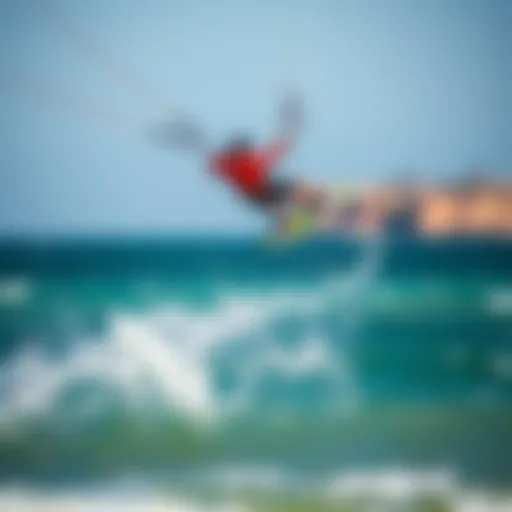Mastering Kite Surfing: A Comprehensive Guide
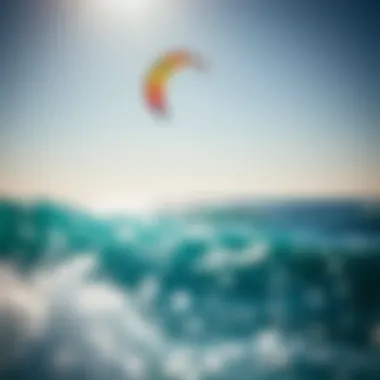
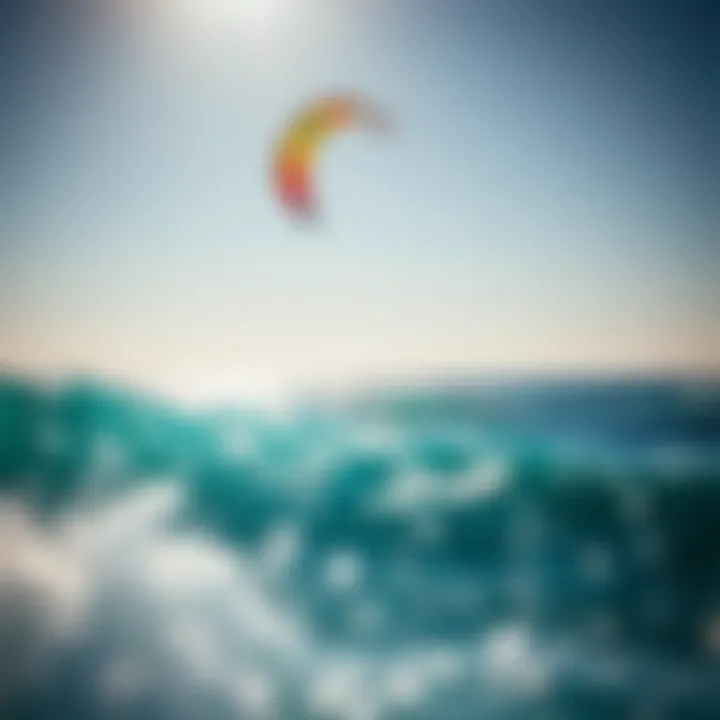
Intro
Kite surfing, a fusion of surfing, windsurfing, and paragliding, has carved out its niche in the realm of adventure sports. The sheer thrill of gliding over the waves, seemingly dancing with the winds, draws people of all skill levels to the water. Whether you’re a curious beginner wanting to give it a try or a seasoned rider seeking to fine-tune your skills, understanding the fundamentals of kite surfing can elevate your experience significantly.
As we unfold this guide, we'll break down various aspects of kite surfing that are essential for mastering the sport. From selecting the right gear to adopting safety practices, we’ll also delve into techniques that can improve your performance. This guide not only addresses common hurdles but also provides strategies to overcome them. So, buckle up as we embark on this exciting journey into the world of kite surfing!
Gear and Equipment
A good kite surfer knows that the right equipment is paramount. Understanding what goes into your kit is half the battle.
Essential Kiteboarding Gear for Beginners
When you first step onto the sandy shores ready to kite surf, having the right gear can make all the difference, ensuring both safety and performance. Here’s a rundown of the essential items you need:
- Kite: Of course, this is the heart of kite surfing. For beginners, a good quality inflatable kite is often recommended as they are easier to control.
- Control Bar and Lines: This setup helps you steer the kite effectively. Keep an eye out for kites that come with durable line systems.
- Harness: A comfortable harness is crucial. You can choose from seat, waist, or hybrid options based on what feels right for you.
- Board: A twin-tip board is great for beginners. They’re designed for easy rides and can be used in both directions.
- Safety Gear: This includes a helmet, impact vest, and possibly even a flotation device for added protection when you're starting out.
As you gain confidence and experience in the water, you will likely want to explore new gear that suits your style and conditions.
Advanced Equipment for Experienced Riders
Once you’ve got the basics down, the equipment can start to vary based on your skill level and personal preferences. Here are some elements you might consider upgrading:
- Performance Kites: These kites are designed for speed and higher jumps. Options like the Slingshot Rally or the Naish Pivot are popular among experienced riders.
- Specific Boards for Conditions: Tailored boards, such as directional boards for wave riding or freestyle boards for tricks, can enhance your performance.
- Kite Foils: These are a game changer, allowing you to ride above the water, giving an exhilarating sensation of floating.
- Advanced Control Systems: Investing in a kite with a more sophisticated control system can give you better handling and responsiveness.
Adapting your kit as you progress is crucial. Each piece contributes to performance, safety, and the overall joy of kite surfing.
Techniques and Tips
Moving to the practical side, mastering techniques is where the sport truly begins to shine.
Safety Practices for Kiteboarding
Safety may sound boring, but it’s vital. Kite surfing goes hand-in-hand with risk management. Here are some key pointers:
- Know the Wind Conditions: Strong, gusty winds can change quickly. Always check meteorological data before heading out.
- Understand Your Equipment: Spend time knowing your gear. Proper usage reduces mishaps.
- Self-Rescue Techniques: Learn how to safely get back to shore if things go awry, especially in changing conditions.
- Respect the Surf Zone: Stay clear of other surfers and heed local rules.
These strategies can not only keep you safe but also allow you to enjoy your sessions without anxiety.
Training Techniques to Improve Your Skills
To really catch the wind in your sails, consistent practice and targeted training can make a vast difference:
- Take Lessons: If you’re new, professional instruction from qualified instructors will lay a solid foundation.
- Video Analysis: Filming your sessions can help spot areas for improvement.
- Dryland Training: Practicing on the beach with a trainer kite helps sharpen your skills without the added complexity of the waves.
- Set Goals: Establishing short-term and long-term targets helps track progression and keeps the motivation going.
As you hone your abilities, you’ll find kite surfing not only becomes more enjoyable but also more fulfilling.
"Kite surfing isn’t just a sport; it’s a lifestyle that pushes boundaries and embraces freedom on the water."
This guide aims to provide a framework for both newcomers and experienced riders. As you embark on your kite surfing journey, remember that the ocean is a fickle friend, and respect for the elements goes hand in hand with mastery.
For further reading and resources, visit Wikipedia on Kiteboarding and Britannica's guide to delve deeper into this electrifying sport.
Preamble to Kite Surfing
Kite surfing has become an increasingly popular sport, drawing in a diverse crowd of thrill-seekers and water enthusiasts. This section aims to provide a solid foundation for understanding why kite surfing is not just a recreational activity but also a lifestyle for many. The sport combines elements of wind, water, and skill, allowing individuals to engage with nature while also pushing their physical limits. This guide will explore key aspects like the history, the fundamentals, and the undeniable appeal of kite surfing. The aim is to equip both aspiring and seasoned kite surfers with knowledge that fuels their passion and enhances their riding experiences.
Historical Background
The roots of kite surfing can be traced back to ancient times. The concept of using kites for practical purposes is old; for example, Chinese warlords and fishermen utilized kites for centuries. However, the modern iteration of the sport didn’t develop until the late 20th century. In the 1970s, pioneers began experimenting with inflatable kites for fun on the water. By the ’90s, this evolved into what we now recognize as kite surfing, thanks largely to innovators like Gijsbertus Adriaanszoon Panhuise and his development of the power kite. Over the years, kite surfing gear has drastically transformed, becoming more user-friendly, efficient, and safe, allowing more people to join in on the excitement.
What is Kite Surfing?
At its core, kite surfing involves harnessing the wind's power through a large, controllable kite while riding a board across the water's surface. Riders are essentially pulled by the kite, gliding along and performing tricks, jumps, or even just enjoying the ride. It’s a unique combination of surfing, wakeboarding, and paragliding. The process generally starts with the kite setup, followed by launching the kite, and finally maneuvering across the water with fluid turns and jumps. At its heart, kite surfing is not just about physical prowess; it's about connecting with your environment, feeling the ebb and flow of nature, and reveling in the freedom the water provides.
The Appeal of the Sport
Why has kite surfing garnered such a strong following? The answer lies in its multifaceted nature. Here are some reasons why individuals are drawn to the sport:
- Thrill and Adrenaline: The speed and excitement of zipping across the water, combined with aerial tricks, deliver a rush like no other.
- Sense of Freedom: There's something liberating about riding the wind and waves, leaving worries on the shore.
- Community and Camaraderie: Kite surfers often form tight-knit communities, sharing tips, stories, and experiences, creating a sense of belonging.
- Physical and Mental Benefits: Not only does kite surfing provide a rigorous workout, but many also find a form of therapy in the experience, as the serenity of the ocean blends with the thrill of the sport.
Kite surfing is not merely a sport; it’s a conduit through which one discovers and expresses the full spectrum of human emotion and connection to nature.
As the sport continues to evolve, so too does the community and culture surrounding it, welcoming those ready to embrace both challenge and exhilaration.
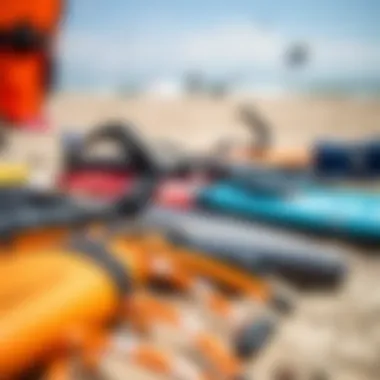
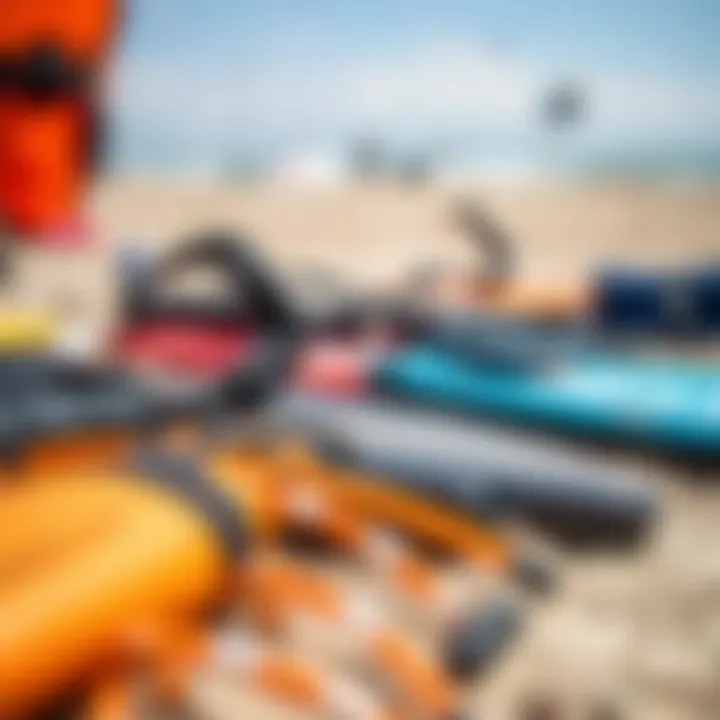
Kite Surfing Equipment Essentials
The kite surfing experience is deeply intertwined with the equipment one uses. The right gear not only enhances performance but also ensures safety and comfort while riding waves. Understanding the critical components of kite surfing gear helps both beginners and experienced riders navigate the myriad of options available. Knowledge in this area can make the difference between a thrilling session and a frustrating one, or, worse yet, a dangerous situation at sea. With kite surfing becoming increasingly popular, knowing the ins and outs of equipment essentials has never been more vital.
Kites: Types and Features
When it comes to kite surfing, the kite itself is arguably the most crucial piece of equipment. Kites come in various shapes and sizes, each designed for different conditions and skill levels. Broadly speaking, there are two main types of kites: inflatable kites and foil kites.
- Inflatable Kites: These are filled with air and have a structure that allows them to float on the water. Ideal for most conditions, they are easy to relaunch and offer significant power when the wind is right.
- Foil Kites: These use the wind to lift the fabric instead of relying on air inside. They are often lighter and can reach higher speeds, but they require more skill to handle and relaunch.
It's not just the type of kite that matters; features like aspect ratio, surface area, and line length significantly influence performance. A wider aspect ratio often gives better upwind performance, while a smaller one could mean more stability in gusty conditions.
For anyone serious about kite surfing, understanding these features is essential. They determine how the kite reacts to both the rider’s inputs and the ever-changing wind conditions. So, when choosing a kite, consider your skill level, the conditions where you'll be riding, and your personal preferences.
Boards: A Comparison of Options
The choice of board is just as important as the kite. Several types of boards cater to different styles and conditions, each with unique characteristics:
- Twin-Tip Boards: These are symmetrical and can go in either direction, making them a favorite for beginners. They’re versatile and work well in various conditions.
- Directional Boards: These boards resemble surfboards and are designed for riding with the front facing the direction of travel. They tend to be better for wave riding and provide more stability at speed.
- Hybrid Boards: A blend of both designs, hybrid boards offer a compromise for those not wanting to commit to one style. They are often favored by intermediate surfers.
The length, width, and flex of the board are also worth noting. A longer board can provide better glide in lighter winds, while a shorter board allows for easier maneuverability, especially during jumps and tricks.
Many riders spend a fortune on gear without fully understanding how board choice affects their performance. Analyzing your riding style, the types of conditions you’ll frequently encounter, and how you like to push your limits can guide you in selecting the right board.
Harnesses and Safety Gear
Safety gear cannot be overlooked when discussing kite surfing equipment. The harness plays a crucial role in how comfortably and effectively a rider can control their kite. There are two main types:
- Waist Harnesses: These are used for most kite surfing activities. They sit around the waist and offer freedom of movement.
- Seat Harnesses: These are great for beginner kite surfers or those who prefer more back support. They are worn lower on the body and connect above the legs.
In addition to harnesses, wearing a helmet is highly recommended. A helmet protects the head against potential collisions, whether it’s with the board or other objects in the water. Impact vests or buoyancy aids, though not mandatory, can provide extra protection and comfort in case of a fall.
Moreover, having a good pair of booties or sandals can prevent injuries to the feet from sharp objects in the water or on the shore. You don’t want to find out the hard way what’s lurking beneath those waves.
A statement often echoed among seasoned kite surfers is: "The calmer you are, the safer you are." Investing in quality safety gear allows surfers to focus on the thrill of the ride, rather than on worrying about potential accidents.
Safety in Kite Surfing
Engaging in kite surfing is a thrilling venture that combines the exhilaration of flying through the air with the fluid grace of gliding over the water. Despite its appeal, safety remains paramount. A solid understanding of safety protocols not only protects you but ensures a more enjoyable experience. When you’re strapped into a harness and maneuvering a large, powerful kite, the stakes are high. By being aware of wind conditions, recognizing potential hazards, and adhering to emergency procedures, you significantly reduce the risks associated with this dynamic sport.
Understanding Wind Conditions
Wind can make or break your kite surfing session. The right conditions can elevate your skills to new heights, but unfavorable winds may bring chaos. It’s essential to grasp how wind works—understanding speed, direction, and patterns is crucial. Even intermediate kiteboarders can falter when failing to check the wind before heading out.
- Wind Speed: Ideally, wind should range from 12 to 25 knots for reliable kite surfing. Too little wind, and you’ll be stuck; too much, and you risk losing control.
- Wind Direction: Off-shore winds can pull you out to sea, a dangerous scenario for unprepared surfers. On-shore winds can be gusty and unpredictable, leading to unstable flying conditions.
- Gusts and Lulls: Changes in wind strength can happen in the blink of an eye. Watching flags, ripples on the water, and other surfers can give you cues about the shifts.
To safely navigate these elements, always check local weather updates, and consider getting accustomed to specific locations before tackling new spots.
Recognizing Hazards
The water may seem inviting, but it can hide dangers lurking just beneath the surface. Awareness of potential hazards is a critical component of kite surfing safety. Here are some hazards to keep in mind:
- Obstacles like rocks, reefs, or pilings: These can quickly turn a fun ride into a hazardous incident. Check location maps, and look for fellow surfers’ feedback about specific spots.
- Other water users: Surfers, swimmers, and boats all share the water. Practicing proper etiquette and keeping your distance can avoid collisions.
- Changing weather: Conditions can shift suddenly. Dark clouds or increasing wind speed can indicate an impending storm. Always be prepared to head back when the sky looks menacing.
Recognizing these dangers allows you to make informed decisions. Turn your head, stay alert, and ensure you have a keen eye on your surroundings.
Emergency Procedures
Even with the best planning, things can go awry. Knowing how to respond in an emergency can save lives. Here are steps you should practice:
- Self-Rescue Techniques: Familiarize yourself with basic self-rescue skills to manage situations like being separated from your kite. Learn how to re-rig and launch your kite safely.
- Communicate with others: Carry a whistle or ensure your kiteboard’s safety handles are easily accessible. Signaling to others can attract help in a pinch.
- Know the emergency services: Familiarize yourself with local emergency contacts and procedures. Knowing who to call and how locations work can save precious time if needed.
Incorporating these emergency protocols into your kitesurfing practice can provide peace of mind, allowing you to focus on enjoying your time on the water.
Kite surfing is as much about adventure as it is about safety. With a solid understanding of wind conditions, an acute awareness of hazards, and comprehensive emergency protocols, you’re not just protecting yourself but cultivating a culture of safety within the kite surfing community.
Techniques for Beginners
When it comes to kite surfing, mastering the fundamentals is vital. For beginners, the starting point sets the stage for progress in this exhilarating sport. Understanding basic techniques can enhance not just skills but also the overall experience on the water. There’s something incredibly empowering about feeling the wind catch your kite, propelling you across the water. It’s all about building a solid foundation to ensure confidence and safety while riding waves. Let's explore key areas, starting with launching the kite, controlling it, and then delving into riding techniques.
Launching the Kite
Successfully launching the kite requires understanding both the equipment and environmental conditions. While it may seem straightforward, if things go awry, it can lead to accidents, which is why practice is essential. The first step in the process is to ensure the wind direction is suitable for launching. You should face the kite into the wind—this provides the lift necessary to get it into the air.
Here are some tips to keep in mind:


- Inspect Your Gear: Always check your kite, lines, and safety equipment before launch.
- Positioning: Have someone assist you. This can help stabilize the kite while you prepare.
- Safety First: Make sure the area is clear of other people and obstacles.
To launch, pull the control lines taut. Gradually pull on one side of the control bar to guide the kite into the air, maintaining an eye on its position in the sky. This might take some trial and error to perfect, but once you get it right, the thrill of seeing your kite soar is unmatched.
Controlling the Kite
Once the kite is airborne, your focus shifts to controlling its movement. This is a crucial aspect of kite surfing as it directly influences your ride. Steering the kite is done through the control bar; pulling one side or the other will change the kite’s direction.
Several important factors include:
- Understanding Power Zones: The forward area where the kite generates the most lift is known as the power zone. Positioning the kite at different angles relative to the wind greatly affects speed and lift.
- Depower Mechanism: Most modern kites have a depower feature that allows you to reduce lift, helping to manage speed especially during gusty conditions.
- Body Positioning: Your body weight plays a vital role in kite control. Leaning into the wind or shifting weight from side to side can help with steering and stability while flying.
With practice, you’ll develop an intuitive sense of how to manipulate the kite effectively. This skill is what separates competent riders from novices and underscores the importance of responsible kite control.
Basic Riding Techniques
Now, let’s get into the heart of the matter—riding techniques. The thrill of gliding across the water is one of the most rewarding experiences in kite surfing. For beginners, the goal is to master the fundamentals before taking on more advanced maneuvers.
Here are a few basics to nail down:
- Positioning on the Board: Your feet should be placed correctly on the board, heel-to-toe alignment helps with balance and control.
- Edging: This involves applying pressure on the edge of the board to maintain speed and direction. A gentle tilt of the board can help you carve through the waves.
- Keeping Your Eyes Up: Always look where you want to go—this aids in steering and balance, allowing you to anticipate the wave movements.
With practice, these techniques will come together, building the rider’s confidence on the water. You’ll find that theory meets reality most excitingly when you stand up and catch those first rides.
As you work on these basics, remember that patience is key. Everyone was a beginner at some point, and putting in the hours will pay off in exhilarating rides in the future.
Advanced Kite Surfing Techniques
Advanced kite surfing techniques represent the pinnacle of what riders can achieve in this exhilarating sport. Mastering these skills not only enhances the thrill of kite surfing but also significantly boosts overall safety and control on the water. As riders progress beyond the fundamentals, the enjoyment comes from pushing personal limits and expressing creativity through tricks and maneuvers.
The importance of these techniques cannot be overstated. They allow kiteboarders to navigate challenging conditions and perform spectacular stunts, making the experience more fulfilling. Moreover, being proficient in advanced techniques often means improved understanding of wind and sea conditions, which is crucial for safety and performance. Prospective kite surfers should look at these techniques not as mere skills but as gateways to a richer, more exciting experience on the water.
Jumping and Tricks Overview
Jumping is one of the hallmark moves in kite surfing—a quintessential showstopper that captures the essence of the sport's thrill. When a kiteboarder successfully launches into the air, it’s not just about getting airborne; it’s about the blend of timing, technique, and a deep understanding of one's equipment. To perform jumps effectively, the rider must be able to generate power from the kite while simultaneously maintaining balance on the board.
Kiteboarders usually start by carving upwind before edging downwind to create the tension necessary for launching. This initial speed builds upon itself; when the kite is pulled up and forward, the rider can catch the air beneath them, resulting in a leap that seems almost effortless. Once airborne, riders can add flair with spins or flips, showcasing personal style.
Key Points to Consider for Jumping:
- Edge Control: It's vital to have a good edge to maintain speed before takeoff.
- Timing: Properly timing the kite's movement is crucial for generating lift.
- Body Positioning: Keeping a tight posture helps in retaining control mid-air.
Boost Techniques: Getting Air
Boosting is a step further into jumping, focusing on maximizing height and airtime. It’s the holy grail for many kite surfers looking to impress spectators and themselves alike. Boosting requires not only the artistry of jumping but also an understanding of how to manipulate the kite's power and wind dynamics to achieve extraordinary height.
To get that coveted boost, riders typically utilize a technique called "pop," which involves hitting the board down hard before launching into the air. This move generates extra lift while the kite is correctly aligned with the wind. Proper kite positioning—often high in the window—creates lift and allows the kite surfer to rise significantly higher than with basic jumps.
Techniques for Effective Boosting:
- Kite Positioning: Keep your kite high in the wind window for more lift.
- Pop and Release: Mastering the pop technique ensures maximum height is reached.
- Spotting the Landing: Always be aware of where you'll land to prepare for a smooth touch down.
Handle Pass and Other Advanced Moves
One of the more challenging areas of advanced kite surfing lies in moves that involve passing the kite handle. Handle passes are essential for adding complexity and flair to any routine. Riders will usually combine a jump with a twist, allowing them to pass the handle from one hand to the other while in mid-air. It’s a challenging move that showcases skill and control.
To successfully execute a handle pass:
- Take-off: Begin with a solid jump. Height is essential for the move.
- Twist: As you reach the peak of your jump, twist your body to shift your grip.
- Pass: Quickly pass the handle from one hand to the other while maintaining body control.
- Land: Secure grip on the handle again for a controlled descent.
Other advanced maneuvers—like rotations and board-offs—can also enhance the kite surfing experience, pushing the limits of what's possible on the water. These advanced skills are all about honing technique, maintaining focus, and practicing consistently.
As the kite surfing community continuously evolves, these advanced techniques reflect the sport’s dynamic nature, inspiring riders to keep reaching new heights. Whether you're jumping for joy or passing handles mid-air, these skills can create an unforgettable spectacle.
Choosing Kite Surfing Destinations
Selecting the right kite surfing destination can truly make or break your experience on the water. The combination of wind conditions, weather patterns, and local culture can influence the quality of your sessions and your overall enjoyment of the sport. Each destination presents unique features that cater to different skill levels and preferences, making it essential for every kiteboarder to consider these factors before packing their gear.
When you choose a spot that has favorable wind conditions and stunning scenery, you can optimize your learning curve and performance. Plus, immersing yourself in local kite surfing communities can enrich your experience, letting you connect with likeminded individuals who share the passion for the sport. In this section, we’ll dive into key spots that kite surfers flock to, seasonal considerations to keep in mind, as well as the do’s and don’ts dictated by local customs.
Top Global Spots for Kite Surfing
The world is dotted with incredible spots where kite surfing enthusiasts can unleash their skills. Here are some of the most celebrated destinations:
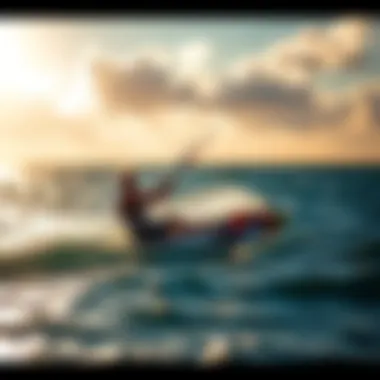
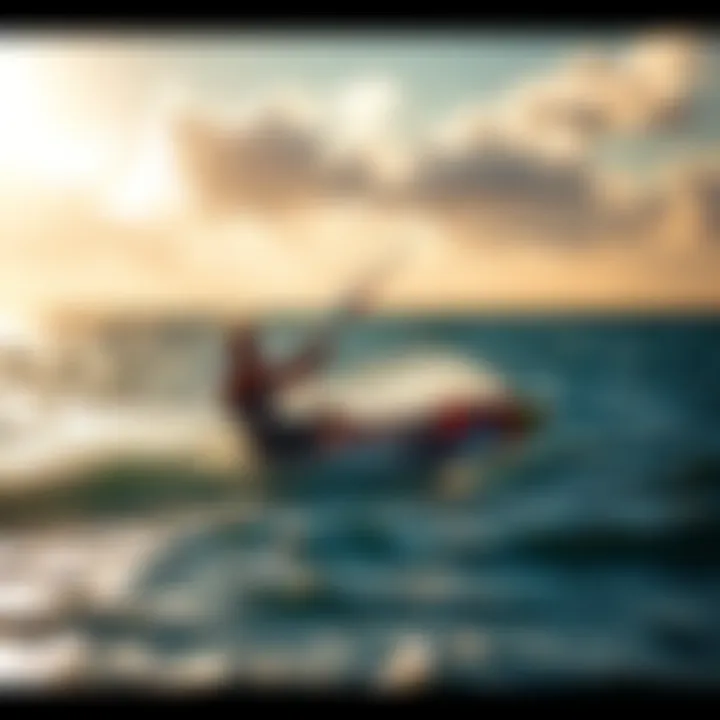
- Maui, Hawaii: Known for its powerful winds and stunning landscapes, Maui is a mecca for kite surfers, offering both flat water and wave riding opportunities. The strong trade winds provide consistent sail conditions year-round.
- Tarifa, Spain: Often referred to as the wind capital of Europe, Tarifa benefits from both Levante and Poniente winds, creating an ideal environment for all levels from beginners to advanced riders. The vibrant local scene is a bonus!
- Cape Town, South Africa: With breathtaking backdrops like Table Mountain and consistent winds, Cape Town has become a favorite for kite surfers looking to enjoy some world-class conditions.
- Le Morne, Mauritius: This spot is famous for its lagoon, where the flat waters make it perfect for beginners. It also offers stunning scenery, with the imposing mountains providing an awe-inspiring backdrop.
- Cumbuco, Brazil: Known for its endless flat water conditions and warm weather, Cumbuco is perfect for those looking to kite surf during the northern hemisphere winter.
Exploring these destinations not only enhances performance but also allows for cultural immersion and more meaningful experiences.
Seasonal Considerations
Timing can be everything when kite surfing. Each destination has its peak season, which often influences wind patterns and weather conditions:
- Maui (Best from May to October) has trade winds, but off-season months can see variable conditions.
- Tarifa's wind intensity peaks in the summer months; you’d want to avoid the peak tourist times if you wish for a quieter experience.
- Cape Town thrives from November to March due to the summer winds.
- Le Morne keeps the breezes flowing most of the year, providing a predictable environment for both newcomers and seasoned pros.
- Cumbuco’s best months align with the Brazilian summer, from June to December.
Understanding when to visit each spot can help in maximizing your session quality, giving you the greatest chance of enjoying solid wind conditions without overcrowding.
Local Regulations and Etiquette
Every kite surfer, whether just starting out or seasoned, should be informed about local regulations and etiquette. Different locales might have specific rules—like no kite surfing in certain areas during peak times for safety and environmental preservation:
- Always check for kite zones and local bylaws.
- Avoid kiting in designated swimming areas to ensure both your safety and others’.
- Respect local customs; a friendly wave or nod can go a long way in building camaraderie with fellow kite surfers.
- Certain places may have restrictions on size of kites or specific gear, hence checking ahead might save you from potential fine or frustrating experience.
By taking your time to understand the ins and outs of your chosen kite surfing destination, you set yourself up for an experience that is not only enjoyable but also respectful of the local culture and environment. Being in harmony with the location enables not only a thrilling ride but also the chance to give back to the communities that provide these beautiful experiences.
Kite surfing is more than just a sport; it’s an adventure that connects you with nature and the community. Take the time to choose wisely.
Community and Culture in Kite Surfing
The community and culture within kite surfing are not just a backdrop; they are pivotal to the experience and growth of the sport. Kite surfing attracts a diverse group of individuals, ranging from thrill-seeking adventurers to serene beach lovers. This blend fosters a unique environment where knowledge is shared, bonds are formed, and camaraderie is cherished. Focusing on community aspects enhances skills, builds friendships, and promotes a sustainable approach toward the sport.
Joining Kite Surfing Clubs
Joining clubs is a gateway for both novices and seasoned surfers. These clubs typically provide structured lessons, community events, and a wealth of knowledge on equipment and techniques. More importantly, being part of a club opens doors to a network of like-minded individuals who share a passion for maneuvering across the waves.
- Benefits of Club Membership:
- Access to workshops on safety and advanced skills
- Organized trips to prime kite surfing locations
- Opportunities to borrow equipment or receive discounts on gear
- Networking with a mentor who can guide your progress
Participating in Competitions
Competitions, whether local or international, can be a thrilling way to immerse oneself in the kite surfing culture. These events showcase riders' skills and provide a platform for enthusiasts to cheer for their favorites. Besides the realization of personal goals, contests often focus on community building by fostering a friendly rivalry.
- Reasons to Compete:
- Boosts personal confidence and showcases your skills
- Encourages learning through observation of other riders
- Creates bonds with fellow competitors and spectators
- Vital for aspiring professionals to gain exposure
The Kite Surfing Lifestyle
The kite surfing lifestyle extends beyond the action on the water. It encapsulates a philosophy of freedom, adventure, and respect for nature. Riders often find themselves moving from one picturesque beach to another, with each destination providing a unique backdrop and experience. This travel-centric lifestyle often leads to strong ties with the environment and commitments to its protection.
"Kite surfing isn't just a sport; it's a way of life that celebrates the wind, the water, and the vibrant community that surrounds it."
- Key Aspects of the Lifestyle:
- Emphasis on environmental awareness and sustainability
- Exploration of diverse cultures in different locales
- A focus on health, fitness, and mental well-being
- Creation of lifelong friendships through shared experiences
By engaging with the community and culture in kite surfing, individuals deepen their understanding of the sport, cultivate lasting relationships, and develop a greater appreciation for the natural world. This interconnectedness is what truly makes kite surfing not just an activity but a vibrant culture.
End and Future of Kite Surfing
Kite surfing, with its blend of exhilaration and skill, is ever-evolving. As we look towards the horizon, understanding the future of this sport and its trajectory becomes imperative for both enthusiasts and newcomers. The importance of focusing on the future lies in the need to adapt to changing conditions—be it technological advancements in gear or shifts in environmental regulations that may affect where and how we ride.
Evolving Techniques and Gear Advances
The kite surfing world is not static. Each year, advancements in techniques and gear create opportunities for riders to elevate their experience. Let's delve into a few key developments:
- Materials and Design: Kites are becoming lighter and stronger, utilizing new materials that improve durability and performance. For instance, the shift to high-tenacity fabrics reduces wear from UV rays and salt, extending the lifespan of kites significantly.
- Control Systems: Newer control systems offer better responsiveness and precision, allowing riders to execute complex maneuvers with greater ease. These innovations often include features like one-pull launches that simplify the process for beginners.
- Adaptive Gear: Many boards now come with adjustable bindings and sizes, catering to various skill levels and riding styles. This adaptability encourages a broader audience to engage and grow within the sport.
"Innovation in gear allows kite surfers to push their limits, turning each run into an opportunity for mastery."
As we embrace these advancements, it’s essential to stay informed and take part in ongoing education within the sport—attending workshops or following skilled kite surfers on platforms like reddit.com can enhance your knowledge.
Environmental Considerations
As adventurous as kite surfing might be, it doesn't come without responsibilities. Environmental factors play a crucial role in the sustainability of kite surfing as a sport. Here are some considerations:
- Impact Awareness: Awareness around the ecological footprints of our activities must increase. This includes being mindful of local wildlife and habitats during trips.
- Sustainable Practices: Many riders are adopting eco-friendly practices, such as using biodegradable wax for their boards and opting for brands focused on sustainability.
- Regulation Changes: Local and global regulations to protect marine environments are on the rise. Staying compliant with these rules not only protects nature but also preserves spots for future kite surfers.
Final Thoughts on the Sport
The journey of kite surfing is marked by a passionate community and a spirit of adventure. Reflecting on its past while eyeing the future provides a unique perspective on this sport. As we leave you with some closing thoughts, consider the following:
- Embrace Learning: Whether you are new to the sport or have been riding for years, continuous learning is key. Engage with peers, explore new techniques, and don't shy away from seeking feedback.
- Community Involvement: Join clubs or events to connect with fellow kite surfers. Whether it’s casual meet-ups or competitions, building camaraderie enriches the overall kite surfing experience.
- Stay Inspired: With exciting advances on the horizon, let your adventures inspire you to push boundaries, both personally and for the sport. Keep riding the waves of innovation, enjoyment, and environmental stewardship.
As we witness the evolution of kite surfing, let's carry forward the spirit of the sport with respect for its roots and excitement for what is to come.



